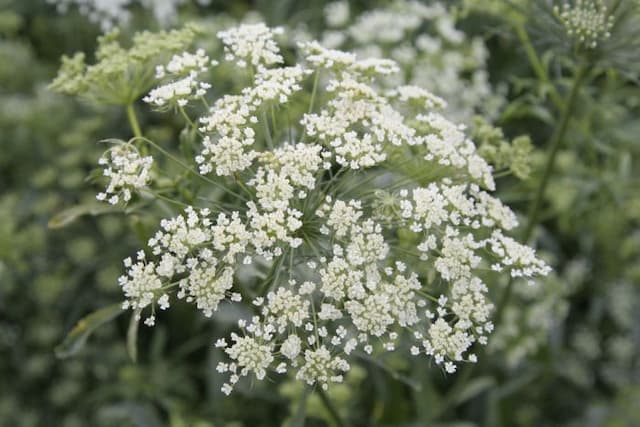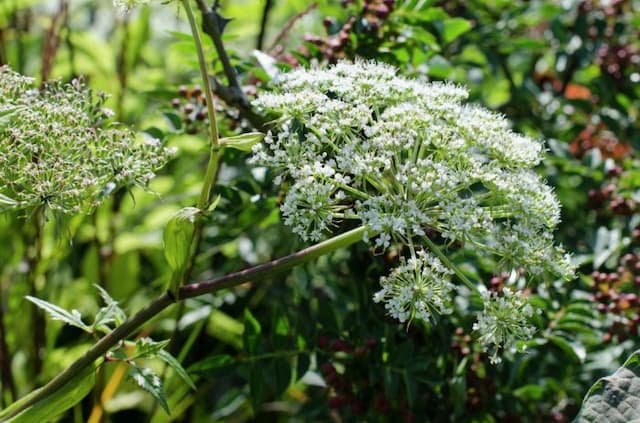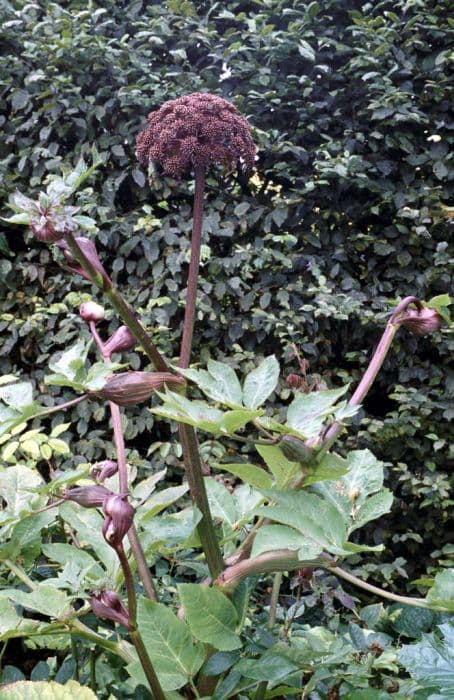Flat Sea Holly Eryngium planum 'Seven Seas'

ABOUT
Eryngium planum 'Seven Seas', commonly known as Sea Holly, is a strikingly ornamental plant notable for its spiny-toothed leaves and thistle-like blue flowers. These blossoms are tightly packed, small, and spherical, resembling tiny globes that cluster together forming larger, dome-shaped flower heads. They emit a metallic, almost iridescent blue shade, sometimes touched with a hint of silvery grey, which gives the plant a distinctive allure in the garden. The foliage of Sea Holly is equally interesting, featuring a rosette of basal leaves that are deeply cut and exhibit a spiky appearance. The leaves are typically a bluish-green color, contributing to the plant's overall cool-toned aesthetic. They may have a slightly prickly texture too, adding an intriguing tactile element to the plant. Throughout its blooming period, Sea Holly can attract a variety of pollinators, including bees and butterflies, thanks to its nectar-rich flowers. Despite its somewhat aggressive look, the plant is commonly appreciated for its unique visual interest and is often employed in flower arrangements and as dried flowers due to its ability to retain color and form after drying. Its robust presence is also an asset to garden designs that aim to incorporate plants with strong structural elements and striking colors.
About this plant
 Names
NamesSynonyms
Flat Sea Holly, Blue Eryngo, Sea Holly, Plains Eryngo
Common names
Eryngium planum.
 Toxicity
ToxicityTo humans
Eryngium planum, commonly known as Sea Holly, is not known to be toxic to humans. Generally, it is considered safe and there are no common reports of poisoning upon ingesting this plant. However, as with any plant, individual allergies or sensitivities could occur, so it is always best to exercise caution and avoid ingesting plants that are not known to be edible.
To pets
Sea Holly is not commonly listed as a toxic plant to pets, including dogs and cats. It does not typically cause poisoning if ingested. However, as with any non-food plant, ingestion may potentially result in mild gastrointestinal upset due to the novelty and fibrous nature of the plant material. If you suspect your pet has ingested a large amount of this plant and is showing signs of illness, it is best to consult a veterinarian.
 Characteristics
CharacteristicsLife cycle
Perennials
Foliage type
Deciduous
Color of leaves
Green
Flower color
Blue
Height
2 feet (0.61 meters)
Spread
2 feet (0.61 meters)
Plant type
Herb
Hardiness zones
5
Native area
Europe
Benefits
 General Benefits
General Benefits- Attracts Pollinators: Eryngium planum 'Seven Seas' is known to attract bees, butterflies, and other beneficial insects which are important for pollination.
- Drought Tolerance: This species is drought-resistant, which makes it suitable for xeriscaping and for gardeners in areas with low water availability.
- Low Maintenance: It requires minimal care once established, which is ideal for those who want an attractive garden without intensive upkeep.
- Deer Resistant: The plant is not preferred by deer, which is beneficial for gardens in areas where deer predation is a problem.
- Unique Visual Interest: Its striking blue flowers and spiky foliage provide a unique aesthetic that can enhance the visual appeal of any garden or landscape.
- Long Blooming Period: With a long flowering season, it provides extended visual impact throughout the warmer months.
- Cut Flower Use: The flowers and foliage are excellent for cutting and using in fresh or dried floral arrangements, adding value for hobbyists and florists alike.
- Adaptability: Eryngium planum 'Seven Seas' can thrive in a variety of soil conditions, from dry to moist, and is adaptable to different garden styles.
 Medical Properties
Medical Properties- Anti-inflammatory: Eryngium planum 'Seven Seas' may possess anti-inflammatory properties, which could help in reducing inflammation.
- Diuretic effect: It has been suggested that this plant may have diuretic effects, aiding in the removal of excess fluids from the body.
- Antimicrobial activity: Some studies indicate that Eryngium planum 'Seven Seas' has antimicrobial properties that could be useful against certain bacteria and fungi.
- Antioxidant: There are indications that the plant contains antioxidants, which are believed to combat oxidative stress and might contribute to overall health.
 Air-purifying Qualities
Air-purifying QualitiesThis plant is not specifically known for air purifying qualities.
 Other Uses
Other Uses- Floral Arrangements: Eryngium planum 'Seven Seas', known as Sea Holly, is commonly used in both fresh and dried floral arrangements due to its unique structure and striking blue color.
- Garden Sculpture: When allowed to dry, the stiff and architectural form of Sea Holly can be used in gardens as a natural sculpture.
- Erosion Control: The deep root system of Sea Holly makes it useful for planting in areas where soil erosion is a problem.
- Textile Dyeing: Historically, the roots and foliage of the plant have been used to produce a blue dye for textiles.
- Decorative Potpourri: The dried flowers of Sea Holly can be added to potpourri mixes for decorative purposes and to add texture.
- Theme Gardens: Sea Holly fits well in xeriscape or seaside-themed gardens due to its tolerance for dry and sandy soils.
- Gift Plants: Due to its unusual appearance and low maintenance, Sea Holly can be an interesting gift plant for garden enthusiasts.
- Photography: The striking form and color of Sea Holly make it a popular subject for botanical photography.
- Art and Illustration: Artists and illustrators may use Sea Holly as a subject in botanical art due to its distinctive appearance.
- Education: Botany and horticulture classes can use Sea Holly to demonstrate adaptations of plants to dry conditions and soil types.
Interesting Facts
 Feng Shui
Feng ShuiThe Sea Holly is not used in Feng Shui practice.
 Zodiac Sign Compitability
Zodiac Sign CompitabilityThe Sea Holly is not used in astrology practice.
 Plant Symbolism
Plant Symbolism- Determination: Eryngium planum, commonly known as Sea Holly, has a resilient nature and thistle-like appearance that embodies a spirit of strong will and persistence.
- Protection: The spiky leaves and bracts of Sea Holly are often seen as symbols of defense and protection, implying that the plant can ward off negativity and harm.
- Independence: Sea Holly thrives in challenging conditions, often growing in poor soil and coastal areas; it thus symbolizes self-reliance and autonomy.
- Attraction: Historically, Sea Holly was believed to possess aphrodisiac qualities and is symbolic of attraction and allure, potentially due to its unusual and striking appearance.
 Water
WaterThe Sea Holly should be watered deeply but infrequently to mimic natural conditions, ensuring the soil has time to dry out between watering sessions. On average, watering once a week during the growing season should suffice, adjusting for rainfall and temperature. During hot, dry spells, you may need to water more frequently, aiming for about 1-1.5 gallons per plant. In the fall and winter months, reduce watering as the plant goes dormant. Consistent overwatering can lead to root rot, so it's important to allow the soil to dry before re-watering.
 Light
LightSea Holly thrives best in full sun conditions where it receives at least six hours of direct sunlight daily. An ideal spot would be in an area of the garden that is open and receives unfiltered sunlight for most of the day. Too much shade can lead to poor flowering and a leggy growth habit.
 Temperature
TemperatureSea Holly prefers moderate to cool temperatures and is hardy in USDA zones 5-9. It can survive minimum winter temperatures down to -20 degrees Fahrenheit and maximum summer temperatures up to around 90 degrees Fahrenheit. The ideal temperature range for robust growth and flowering is between 60 to 75 degrees Fahrenheit.
 Pruning
PruningPruning Sea Holly is mainly done to remove spent flower heads and encourage a second flush of blooms or to maintain its shape. It's best to deadhead the flowers once they have faded, which is typically in late summer or fall. Cutting back the plant in fall or early spring cleans up any winter damage and prepares it for new growth.
 Cleaning
CleaningAs needed
 Soil
SoilSea Holly requires well-draining soil with a mix of sand, compost, and loam to recreate its native habitat. The best soil mix is equal parts of these components with a pH range between 5.8 and 7.2, leaning towards the alkaline side.
 Repotting
RepottingSea Holly, being a perennial, typically does not require frequent repotting. Repot it only if it outgrows its container, which is likely to happen every 2 to 3 years.
 Humidity & Misting
Humidity & MistingSea Holly is tolerant of dry conditions and does not require high humidity levels. Average room humidity is generally sufficient for this plant; it can do well with humidity levels as low as 30-40%.
 Suitable locations
Suitable locationsIndoor
Place Sea Holly in a sunny spot with good air circulation.
Outdoor
Plant Sea Holly in full sun with well-drained soil.
Hardiness zone
5-8 USDA
 Life cycle
Life cycleEryngium planum 'Seven Seas', commonly known as Flat Sea Holly, begins its life cycle when its seeds germinate in early spring, typically after experiencing vernalization - a period of cold to break dormancy. After germination, the plant develops a rosette of spiny, variegated blue-green leaves. As the growing season progresses, Flat Sea Holly enters a vegetative state where it focuses on accumulating resources and growing in size. By mid to late summer, it advances to the flowering stage, producing distinctive steely-blue to violet flower heads atop branched stems, attracting pollinators like bees and butterflies. After pollination, seeds form and mature by late summer to early fall, to be dispersed by wind, water, or animals. With the onset of winter, the plant dies back if it is an annual variety, or it may enter dormancy if perennial, preparing to repeat the cycle the next spring.
 Propogation
PropogationPropogation time
Spring-Early Summer
Eryngium planum 'Seven Seas', commonly known as Sea Holly, is best propagated using seed. Seed propagation is typically carried out in late winter or early spring. To propagate Sea Holly from seed, one should sow the seeds into well-draining seed starting mix, lightly covering them with soil. Since the seeds require light to germinate, do not bury them deeply. The container with the seeds should be kept at a temperature of about 70°F (21°C), and the soil should be consistently moist but not waterlogged. Germination usually takes about two to four weeks. Once the seedlings have developed true leaves and are large enough to handle, they can be transplanted into individual pots or directly outdoors after the last frost has passed, allowing ample space for maturity as this plant spreads.









